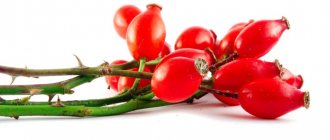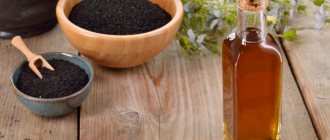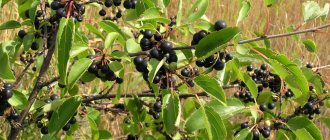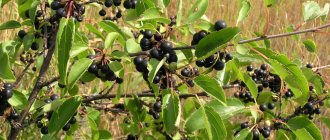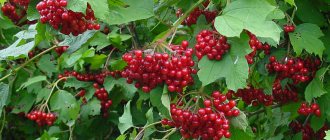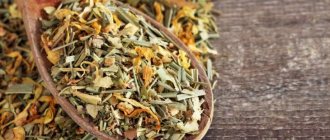Rosehip: benefits and harm; contraindications; chemical composition and calorie content; benefits for men, women and children; how to prepare and take the decoction; recipes for making infusion. The list of user requests is not limited to the specified questions, because everyone who has somehow learned about wild rose (second name) wants to get maximum information about the properties of this plant. In fact, rosehip decoction has medicinal properties, but in some cases it can cause harm to the body, therefore it is contraindicated in the presence of a number of diseases. The seed oil of this garden crop is widely used in cosmetology, as it can quickly solve problems with excessive dry skin, in which it is superior to sea buckthorn oil. Thanks to its unique properties and rich vitamin and mineral composition, the plant serves as a solution to many problems at once, and we’ll talk about this.
Dog-rose fruit
Chemical composition and calorie content of rose hips
The nutritional value of one hundred grams of rose hips is 109.0 kilocalories, this amount contains (grams/percentage of daily requirement, %):
- proteins/1.6/1.7;
- fat/0.7/1.0;
- carbohydrates/22.4/15.7;
- dietary fiber/10.8/54.0;
- water/60.0/2.2.
The chemical composition of the dried fruits of the plant is presented in the table:
| Vitamin/mineral | Content per hundred grams of product, milligrams | Percentage of daily requirement in one hundred grams, % |
| Retinol acetate | 0,434 | 48,2 |
| Beta carotene | 2,600 | 52,0 |
| Thiamine | 0,050 | 3,3 |
| Riboflavin | 0,130 | 7,2 |
| Kholin | 12,000 | 2,4 |
| Pantothenic acid | 0,800 | 16,0 |
| Pyridoxine | 0,076 | 3,8 |
| Ascorbic acid | 650,0 | 722,2 |
| Tocopherol acetate | 1,700 | 11,3 |
| Phylloquinone | 0,026 | 21,6 |
| A nicotinic acid | 0,700 | 3,5 |
| Potassium | 23,000 | 0,9 |
| Calcium | 28,000 | 2,8 |
| Magnesium | 8,000 | 2,0 |
| Sodium | 5,000 | 0,4 |
| Sulfur | 16,000 | 1,6 |
| Phosphorus | 8,000 | 1,0 |
| Iron | 1,300 | 7,2 |
| Manganese | 1,020 | 51,0 |
| Copper | 0,113 | 11,3 |
| Zinc | 0,250 | 2,1 |
The product is a “champion” in terms of ascorbic acid content, but despite the incomparable benefits, a negative effect of this component on tooth enamel cannot be ruled out, so it is better to consume rosehip decoctions through a straw.
General information about rose hips
Rosehip (from Latin rosa) belongs to the rose family (Rosaceae), or Rosaceae. The plant is known as a wild (or wild) rose. However, it is also cultivated on an industrial scale to obtain medicinal and food raw materials. There are about 400 botanical species in nature, of which about 366 are officially registered. About 270 species grow in Russia. There are even more cultivated varieties - from 10 to 50 thousand, because the rosehip is the progenitor of them all.
Rosehip is a shrubby perennial crop that belongs to the Rosaceae family.
The most common types of shrubs in Russia:
- dog rose (Rosa canina);
- cinnamon rose (Rosa cinnamomea);
- May rose (Rosa majalis);
- needle rose (Rosa acicularis Lindl.);
- Daurian rose (Rosa davurica Pall);
- wrinkled rose (Rosa rugosa Thunb).
Species of the genus Rosa are grouped into 8 sections.
Appearance
Rosehip is a perennial, multi-stemmed, deciduous shrub from 1 to 5 m high, which got its name due to its sharp thorns and bristles of different sizes and shapes. The average age of the bush is from 30 to 50 years.
There are unique (100- and 500-year-old) specimens, depending on the region of growth, nutrition, etc.
In the subtropics, forests of Central Asia and the Eastern Caucasus and in the Tien Shan, rose hips appear in the form of evergreen rose lianas, liana-like bushes with long stems intertwined with tree crowns.
The fragrant flowers have a regular shape and can be pink, purple, yellow, cream or white in color. Their diameter is 1.5-10 cm, they are single or 2-3 collected in inflorescences - paniculate or corymbose.
Green leaves have a petiole to which paired stipules grow, with the exception of some species. The color of the leathery leaves is green, bluish or reddish, the average length is about 10 cm.
Rosehip blooms with single buds, and its fruits are small berries.
The seeds are collected inside a bright red, orange or bright yellow flower cup - a hypanthium, crowned with a tuft of remnants of sepals. The bright shade is due to the high content of carotenes.
Places of growth
Wild rose is an amazing shrub that easily adapts to new habitats. It is distributed on almost all continents: Europe and Asia, North America, Africa, Australia and New Zealand. In Europe, the plant prefers mountainous areas: the Caucasus, Carpathians, Crimea. Felt rose hips, so named for the unusual softness of its leaves covered with down, grows in all European countries. In Asia, the spiny variety is found everywhere except deserts and semi-deserts: in Japan, India, Alaska, Sakhalin and the Philippine Islands.
The shrub grows in forest and forest-steppe zones, on the edges and in undergrowth, in meadows, along streams and rivers, on rocks and in clayey ravines, near the sea and high in the mountains.
Composition and calorie content
Nutritional value of rose hips, i.e.
dried fruits (per 100 g) - 284 kcal, fresh - 109 kcal. Protein content - 3.4 g, fat - 1.4 g, carbohydrates - 48.3 g. Proportion of nutrients per 100 g (see table):
| Nutrient | Quantity |
| Vitamin A | 817 mcg |
| Beta carotene | 4.9 mg |
| B1, thiamine | 0.07 mg |
| B2, riboflavin | 0.3 mg |
| Vitamin C | 1000-2000 mg |
| Vitamin E, alpha tocopherol | 3.8 mg |
| RR | 1.4 mg |
| Niacin | 1.2 mg |
| Potassium, K | 50 mg |
| Calcium, Ca | 60 mg |
| Magnesium, Mg | 17 mg |
| Sodium, Na | 11 mg |
| Phosphorus, P | 17 mg |
| Iron, Fe | 3 mg |
| Water | 14 g |
| Ash | 4.7 g |
| Starch and dextrins | 6.2 g |
| Mono- and disaccharides (sugars) | 42.1 g |
| Saturated fatty acids | 0.2 g |
| Organic acids (malic, citric, linoleic, palmitic, linolenic, oleic, stearic, arachidic) | 5 g |
| Alimentary fiber | 23.2 g |
The fruits contain tannins and essential oils.
Useful properties of rose hips
The rich vitamin and mineral composition explains a number of beneficial properties of the plant in the form of the following effects:
- immunostimulating;
- antiseptic;
- tonic;
- stimulating / affects brain activity;
- invigorating;
- anti-inflammatory;
- diuretic;
- wound healing;
- hemostatic;
- diuretic;
- choleretic.
A decoction of the fruit can be used for medicinal purposes, as well as in the prevention of diseases or to relieve fatigue. It is possible that a drink with wild rose may have a beneficial effect on brain activity.
People with stomach ulcers and other diseases (see below) should first familiarize themselves with the contraindications and consult a doctor before using them orally for one or another effect. It should be noted that seed oil and decoction of roots, leaves, and fruits have different types of effects on the human body. Read more about the benefits of rose hips for different categories of people below.
Differences from hawthorn
Hawthorn is a tree or shrub of the deciduous genus, rose family (Rosaceae).
The flowers and leaves look different on the bushes, the fruits are similar due to the presence of hypanthium, which has a red, orange color, but inside the hawthorn there is a hard bone, not seeds. The latter refers to medicinal plants that have a cardiotonic effect on the body.
On the left are rose hips, on the right are hawthorn fruits.
Ripe berries and inflorescences of hawthorn serve as raw materials for the creation of medications prescribed to patients with cardiovascular diseases and nervous disorders.
Benefits and contraindications of rosehip decoction for the body
A conversation about the beneficial properties of a plant for humans should begin with the fact that some of the vitamin and mineral substances are subject to thermal destruction, so preference should be given to infusions or not to exceed a temperature of 80 degrees when making a drink. This condition is a mandatory parameter when working with fruits.
Types of plant effects on the human body:
- immunostimulating;
- normalizing/for the gastrointestinal tract;;
- strengthening/for the cardiovascular system and the whole body;
- stimulating/applies to the respiratory system;
- regenerative/epidermis;
- tonic;
- anti-inflammatory;
- antibacterial;
- synthesis of blood particles/anemia;
- in the form of choleretic and diuretic effects / beneficial for the liver and gall bladder.
If we talk about healing properties, it is worth considering that they are possessed not only by fruits known to everyone from childhood, but also by:
- foliage;
- root part;
- shoots;
- seeds.
From the first three elements, infusions and decoctions are prepared that can solve many problems. Due to the high content of ascorbic acid - three fruits are enough to meet the daily requirement - a decoction of rose hips is indispensable during pregnancy as an effective remedy for colds, anemia and the prevention of vitamin deficiencies. For heart disease, you should prepare a decoction of rose hips and hawthorn.
Despite all the benefits, rosehip decoction has limitations in use - drinking the drink is prohibited for diseases such as:
[product_block id=”11005"]
- gastritis with increased acidity of gastric juice;
- peptic ulcer;
- thrombocytosis;
- tendency to thrombosis;
- endocarditis;
- hypervitaminosis of ascorbic acid;
- salt deposits and other abnormalities associated with water-salt metabolism.
The negative effect on the body is associated with the presence of a large amount of vitamin C in the chemical composition of wild rose, which can negatively affect the functioning of the gastrointestinal tract in the event of inflammatory processes. Rosehip affects blood clotting, which is not at all useful in case of poor circulation, which gives rise to the above contraindications.
Description of the plant
Rosehip is a summer green or evergreen shrub, with erect or climbing, sometimes creeping on the ground, recumbent or creeping stems up to 10 m high or long, covered with hairs or glands. The presence of the latter is associated with a more or less intense aroma emitted by plants. Some species send out underground shoots, which become lignified and form colonies.
Photo: rosehip flowers and berries
Spikes
The trunk and branches are covered with thorns, popularly called thorns. They protect the rosehip from being eaten by animals and help it stay supported. The thorns of the same shrub can be the same or different and differ in shape on short and long shoots. There are especially many of them in areas of the plant located close to the ground.
Leaves
The cutting leaves, imparipinnate, are arranged alternately, most often consisting of 5-9 leaflets, sometimes of 3-4 or 10-19. An exception is the Persian rose (lat. Rosa persica) with simple leaves without stipules.
The plates are smooth, covered with glands or hairs. Small thorns are sometimes found on the stems. The pinnate leaves are of different shapes - from elliptical to ovate, obovate or round, mostly entire or serrated-sawtooth, less often serrated. Stipules are often present, free or fused with the petiole.
Flowers
The flowers are collected in cluster-shaped, paniculate, sometimes umbellate inflorescences, which are apical or lateral. Apical leaves are often formed. The subchassis is missing. There are 5 sepals, only the silky rose hip (lat. Rosa sericea) has four.
Sepals are lanceolate, lamellar, entire, rarely pinnately divided or pinnately dissected. The calyx is covered with hairs or glands. By the time the fruits are ripe, the sepals fall off or remain, crowning them in the shape of a crown.
The diameter of the corolla is 1-10 cm. Five (one species has 4) petals ranging from white and yellow to pink and red. Stamens from 20 to 265. There are numerous (4-140 pieces) unfused carpels. The pistils are usually free, in some species fused to each other.
Fruit
The fruits are polynuts, or cynorhodias. Single-seeded nuts are yellow to brown in color, surrounded by more or less fleshy hypanthium, often covered inside with hairs. Ripe rose hips are soft or hard, sweet and sour in taste, often red to orange, less often brown to black.
On some plants the fruits last a long time, while on others they fall off early.
Read also: Lingonberry - description of the plant and berries, beneficial and harmful properties, composition, calorie content, recipes, photos
Interesting Facts
- The rose hip has a symbolic meaning in German culture. Superstitions and myths that arose during the Middle Ages are associated with it. The fruits were eaten at Christmas and New Year to appease fate and ward off misfortune. In order to protect the house from witchcraft, they were nailed to the window frames.
- The Slavs believed that thorny bushes were created by the devil, since people, having been injured by its sharp thorns, curse, and this is a great sin.
- In Christianity, the plant is a symbol of asceticism, purity, beauty, and youth.
How to prepare and take rosehip decoction
The whole plant has healing properties, so you can prepare a decoction not only from dry or fresh fruits, but also from leaves and young shoots. Each part has a different set of vitamins and minerals, which explains the need to select the composition of the drink according to the type of problem being solved. General characteristics of the decoctions are presented in the table:
| Part | Benefit | Application |
| Escapes | Rheumatism therapy Treatment of radiculitis Elimination of abdominal pain Pronounced diuretic effect | Daily, before meals, 100 milliliters, no more than 4 times a day |
| Leaves | As an effective therapy:
Helps improve digestion, has diuretic and antibacterial effects. | No less than fifteen minutes before meals, no more than two tablespoons |
| Root | Removal of kidney stones, gall bladder Treatment of diarrhea, cystitis, rheumatism, gout, seizures, paralysis, metabolic disorders Relieving pain in the heart | A quarter glass before meals, no more than 4 times a day. Course duration 1-2 weeks |
| Fetus | Indications:
| No more than 200 milliliters per day |
It is necessary to prepare decoctions from any parts of the plant, taking into account all the recipe instructions - this will avoid mistakes, destruction of valuable substances, and loss of healing properties. You should not violate the norms and duration of the course given in the table: in folk medicine, the result depends not on the amount of the drink taken, but on the regularity of its use.
Rosehip is a powerful therapeutic agent, and the article is for informational purposes only, so if you have diseases, you should use the decoction only after consulting your doctor.
If there are no dry or fresh fruits, you can purchase rosehip extract from the pharmacy chain, which has the same positive effects, but is easier to work with - the required amount, according to the instructions, must be combined with warm water.
The decoction perfectly invigorates and refreshes our body
Rosehip root decoction
This drink helps dissolve kidney and gallstones. Before mixing the ingredients, measure out their quantities and prepare all the necessary accessories in advance. To prepare you will need:
- chopped rosehip root/two tablespoons;
- water/five hundred milliliters.
When the components are ready, start making the decoction:
- Wash the root of the plant and remove the peel.
- Grind the pulp using a small-diameter grater.
- Place the indicated amount of the resulting mass in a saucepan and combine with cold water.
- Put it on fire.
- When the mixture boils, cook over moderate heat for at least twenty minutes.
- Cover and set aside to steep for two hours.
- Pass through a sieve or cheesecloth.
Decoction of young twigs
Before mixing the ingredients, measure out their quantities and prepare all the necessary accessories in advance. To prepare you will need:
- chopped shoots/three tablespoons;
- boiling water/five hundred milliliters.
When the components are ready, start making the decoction:
- Rinse the young branches of the plant under running water.
- Dry with a towel.
- Grind, finely chop with a knife.
- Place the required amount of the resulting mass in a boiling container.
- Add boiling water.
- Put it on fire.
- As it boils, cook over very low heat for at least ten minutes.
- Cover with a lid and set aside to steep for one hour.
- Pass through a sieve or cheesecloth.
From rosehip leaves
Before mixing the ingredients, measure out their quantities and prepare all the necessary accessories in advance. To prepare you will need:
- dry leaves/one tablespoon;
- boiling water/one and a half glasses.
When the components are ready, start making the decoction:
- Place the leaves in a container.
- Add boiling water.
- Cover the container with a lid and leave for three hours.
From fresh berries
Before mixing the ingredients, measure out their quantities and prepare all the necessary accessories in advance. To prepare you will need:
- fresh berries/twenty pieces;
- water/one glass.
When the components are ready, start making the decoction:
- Sort the berries and wash under running water.
- Pour boiling water over the fruits of the plant and place in a cooking container.
- Add water.
- Put it on fire.
- Cook for at least ten minutes from the moment of boiling (very low heat, better cover with a lid).
- Remove from heat.
- Set aside for 24 hours to infuse.
From dry fruits
Before mixing the ingredients, measure out their quantities and prepare all the necessary accessories in advance. To prepare you will need:
- dried rosehip fruits/two teaspoons;
- boiling water/one glass.
When the components are ready, start making the decoction:
- Measure the fruits and place them in a coffee grinder to grind.
- Place in a thermos and connect with boiling water at a temperature of no higher than eighty degrees (about five minutes should pass from the moment the water boils).
- Leave for about eight hours. If necessary, you can get by with thirty minutes.
- Pass through cheesecloth.
Rosehip oil is one of the most popular cosmetics for face and hair care.
Properties and uses of rosehip oil
An oil is extracted from wild rose seeds, which has unique properties that are used:
- in the fight against inflammatory processes occurring in the oral cavity;
- to eliminate dermatoses;
- in the treatment of trophic ulcers, bedsores, eczema.
The cosmetic area is not spared from such a useful product due to its pronounced regenerative effect on the epidermis and the structure of the hair shafts. Clinical trials of the product began in the eighties of the last century - accounting was able to identify the following unique effects of the product:
- wound healing;
- removal of scars;
- elimination of scars.
Such world-shaking discoveries prompted scientists to further study the properties of rosehip oil, and by the end of the same century, data obtained after use by women over thirty-five years of age for sixteen weeks appeared and the following effects were revealed:
- improving the appearance of the dermis;
- refreshment;
- eliminating signs of aging.
Such a beneficial effect on the skin made the product very popular for the next two decades - the situation has not changed to this day. Can be used:
- internally/treatment of ulcers, gastritis;
- outward/cosmetic purposes.
The oil has an antidepressant effect, and is also useful for diseases of the digestive system - it solves the problem of decoctions of this valuable product, when the use of rose hips, rich in vitamins and minerals, is contraindicated. Despite the many positive effects, you should always consult a doctor before use.
Contraindications for use on the face:
- oily type of epidermis;
- acne;
- allergic manifestations.
Preparing rosehip infusion in a thermos
You should start preparing the drink by selecting dried berries: you must pay attention to their appearance. If mold appears on the fruits or they are black in color, it is better to discard such fruits. When the fruits are ready you need:
- Rinse the infusion container (thermos) with boiling water.
- Wash the dried fruits (you will need seven pieces) with running water.
- Place the fruits in the prepared bowl.
- Add boiling water in the amount of six hundred milliliters.
- Close the lid of the thermos and leave for at least eight hours.
To enhance the anti-cold effect, you can prepare an infusion with ginger in a thermos, and for liver cleansing - with oats in a thermos. For a general strengthening effect, it is enough to drink green tea with rose hips every day.
Which rosehip to choose
There are many varieties of rose hips. Scientists have been trying to systematize them for several centuries, but so far they have not succeeded. Research has shown that different varieties of shrubs differ in the chemical composition of the fruit.
Some contain much higher levels of vitamins and various microelements than others. The amount of vitamins and essential oils in rose hips is also influenced by the place where it grows. Wrinkled and spiny rose hips are of industrial importance, containing from one to 4.5% vitamin C per fresh weight of the fruit. And for Begger’s rosehip this figure generally ranges from 7 to 20%.
But if you are not a scientific botanist, and you do not have the opportunity to go to the banks of the Irtysh or to Kazakhstan to pick rose hips, then collect them near your home. But there are basic rules:
- rose hips are collected far from roads and industrial enterprises;
- the fruits must be fully ripe;
- Rose hips are collected before frost, later they lose their beneficial properties;
Low temperatures destroy vitamin C, so berries are harvested in August-September. You can buy dried rose hips at the pharmacy.
Medicinal properties of rose hips
For pancreatitis
The plant has undoubted benefits for pancreatitis, because rosehip reduces cholesterol, has a choleretic effect, and eliminates spasms. It is prohibited to use during periods of exacerbation of the disease.
For the liver
The pronounced choleretic effect of drinks with the plant helps improve liver function. Rose hips contain vitamin substances that can complement the structure of the cells of an organ such as the liver and prevent the formation of adipose tissue.
For the kidneys
The diuretic effect on the body and the ability of a drink with wild rose to destroy stones formed in the kidneys and gall bladder make it healing for the kidneys.
For diabetes
If you have this disease, doctors recommend the use of rose hips due to its rich vitamin and mineral composition and ability to reduce the amount of cholesterol in the blood.
For immunity
A drink made from the fruits of the plant has a pronounced immunostimulating effect during colds, because three berries contain the daily requirement of ascorbic acid. To treat diseases, it is recommended to consume one hundred milliliters of rosehip decoction four times a day. Do not overuse - it is not advisable to use it for longer than eight weeks.
Infusions improve immunity
Apple
Rose hips of the Apple variety usually do not grow higher than 1.2 m, however, the yield is not inferior to tall varieties. The flowers, like the fruits, are dark red. The rose hips of this variety are large and often grow in groups of 5-7 pieces. They have a flat-round shape and a sweet and sour taste. A bush with ripe fruits looks very elegant.
| Purpose | Plant height | Fruit ripening | Winter hardiness |
| Up to 1.2 m | From mid-August | High | |
Rose hip infusion recipes
Tea with honey and rosehip
Before mixing the ingredients, measure out the quantities and prepare all the necessary accessories in advance. To prepare you will need:
- dried berries/twenty pieces;
- honey/fifteen grams;
- lemon juice/five grams;
- boiling water/two hundred milliliters.
When the components are ready, start making the infusion:
- Grind the fruits in a coffee grinder.
- Combine the resulting powder with water.
- Place the mixture on the fire and cook for at least ten minutes after boiling, covering with a lid.
- Set aside for ten minutes to infuse.
- Strain.
- Add honey and freshly squeezed lemon juice.
Harm and contraindications of rose hips
Despite its beneficial properties, wild rose is not without its disadvantages:
- negative impact on tooth enamel in the form of destruction;
- side effects if the recommended amounts per day are not observed.
These defects are completely correctable, because it is enough to follow the instructions for the daily intake and use a straw for drinking.
Rosehip helps to increase the coagulability of blood particles, which people with an increased tendency to thrombophlevititis should pay attention to and should not use products based on this plant. Further use is contraindicated when symptoms of individual intolerance in the form of allergic reactions are identified. If these or other deviations are present, you must first discuss the possibility of use with your doctor or therapist.
Growing conditions
Most wild roses are light-loving and grow only in open areas, but there are also some that tolerate shade or partial shade well. Temperature is of secondary importance for many. Some species (R. gallica, R. jundzillii, R. stylosa) develop better in warm places, others (R. pendulina) - in cooler places, for example, in the mountains. The soil should be slightly acidic to slightly alkaline, not saturated with nitrogen.
The plants form dense thickets and are used to create hedges. They can be found on forest edges, in the undergrowth, along rivers, and on sand spits.
FAQ
How much rosehip decoction can you drink per day?
When determining the daily norm, you should take into account the age category, milliliters:
- no more than two hundred – adults;
- no more than a hundred are children.
It is important to consider not only the daily volume, but also the purpose of use:
- weight loss - one hundred milliliters before meals;
- increasing immunity - no more than four times a day, one hundred milliliters;
- improving the absorption of minerals (calcium, iron) – two hundred milliliters before bedtime once a day;
- choleretic effect - two hundred milliliters before breakfast.
Thus, depending on the tasks, the daily dose can be consumed immediately or divided into several times. You should not use this remedy without breaks - the maximum duration of the course is eight weeks, the minimum is three.
How long should rosehip decoction be stored?
The finished decoction of rose hips can be stored under normal conditions for no longer than eight to ten hours due to the possible fermentation process. To increase the shelf life of the product, you should pour it from a thermos into another container in the morning, cover it with a lid and put it in the refrigerator. Under such conditions, the drink retains its properties for no longer than forty-eight hours.
Habitat
Cinnamon rose hips are widespread in most of the CIS. It can be found in the European part - with the exception of the Baltic countries and the Black Sea region of Russia, in Western Siberia - with the exception of the Far North, in Eastern Siberia - in the Angara-Sayan region, in the Yenisei region the plant is rare, as well as in Central Asia.
Rose hips grow in sparse mixed and deciduous forests, among shrubs, along the edges, clearings, meadows, along ravines and mountain gorges, on rocky slopes, preferring the banks of rivers, lakes and other bodies of water. There are both single plants and groups (thickets).
Reviews
According to average statistics of data from different sites on customer opinions, the rating of rose hips as an effective remedy for colds is 5.0 points out of a possible 5.0. The plant is recommended by 100% of satisfied customers, which indicates beneficial properties for the human body.
Maxim, 29 years old
In the spring, after working at the dacha, I discovered that the skin on my hands was not just dry, but began to crack severely. I found information on the Internet that you can solve the problem with rosehip oil. I rubbed it into problem areas for two weeks and the result was healthy skin. I recommend.
Yuliana, 34 years old
Once upon a time, in our childhood, my mother and my brother spoiled me with rosehip decoction. Now I also drink so as not to get sick and it helps. It is better to drink through a straw to avoid damaging tooth enamel. I recommend.
Yana, 25 years old
I drink rosehip decoction in two-week courses, combined with regular use of hair and face masks with oil from the same plant. After three years of use, I can note an improvement in the appearance and condition of hair, nails, and facial epidermis. I recommend for purchase and use.
Rose cinnamon
(Rosa cinnamomea) is another common type of rose hip, which is most often found in the Urals, Siberia and the Volga region. This shrub is slightly taller than wrinkled, but does not exceed two meters.
The shoots of this shrub are thin and have a burgundy tint. The flowers are fragrant and have a very attractive appearance - pink or dark red.
This type of rose hip has the highest percentage of vitamin C content (about 3000 mg). The yield of this shrub is significantly less than wrinkled rosehip - 1 kg per bush.
Rosehip is a plant that is very resistant to low temperatures. And this includes all their types. They are able to survive even in temperatures of -35 degrees below zero. With a sharp drop in temperature during the winter season, the rosehip may only freeze slightly.
conclusions
- Rose hips are rich in vitamins and minerals; three berries contain the daily requirement of ascorbic acid.
- The whole plant is useful: decoctions can be prepared from the root, fruits, twigs, and leaves.
- A pronounced immunostimulating effect, stimulation of brain activity, elimination of fatigue, tonic effect on the body are not all types of beneficial effects on the body.
- Due to the high content of ascorbic acid, systematic consumption of drinks with rose hips can lead to the destruction of tooth enamel, so it is better to use a straw.
- The product has contraindications, so you should consult your doctor before use.
Oval
Medium ripening variety. The Oval rosehip bush grows small, the flowers are also not too large, and white. The fruits are slightly flattened, red, with thick skin and sweet, juicy pulp. The variety is frost-resistant, not susceptible to disease, and insects rarely damage bushes. The berries are most suitable for processing, but are also suitable for drying.
| Purpose | Plant height | Fruit ripening | Winter hardiness |
| Up to 1.5 m | From mid-August | High | |
